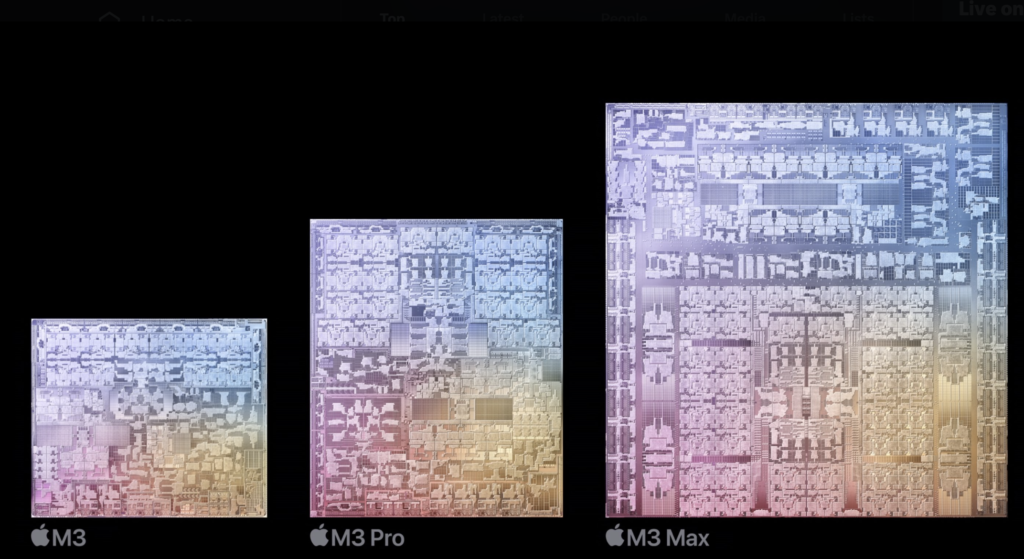Introduction
In a “Scary Fast” product unveiling event, Apple Inc. made significant announcements that have the tech world buzzing around its M3 Chips.
Among the highlights were the introduction of the M3 chip and new MacBook Pro models, as well as an updated 24-inch iMac running on the M3. These innovations signify Apple’s continued push to remain at the forefront of the industry.
In this comprehensive review, we dive into the details of these new products and explore whether they are worth the upgrade.

The M3 Chip: A Technological Marvel
Apple’s proprietary semiconductor division, known as Apple Silicon, has proven to be a game-changer. Since transitioning from Intel components to their in-house chips in 2020, Mac sales have surged. This shift has been fueled by increased tech spending during the pandemic. However, more recently, Mac sales have faced challenges, with revenue beginning to decline.
Apple’s M3 chip impresses with its advanced features and manufacturing technology. Built on cutting-edge 3-nanometer architecture, this chip represents a leap in performance and graphics processing capabilities.
Built on a 3-nanometer architecture, the M3, M3 Pro, and M3 Max chips are not merely incremental upgrades. They represent a significant leap forward in chip technology.
Apple aims to reinvigorate its standing in the industry and reignite Mac sales with the launch of the M3 chip.
The base model offers eight main cores and an additional 10 cores for graphics processing, promising users a seamless and efficient experience.
During the event, Apple provided tantalizing glimpses of their capabilities. But the burning question is whether these chips are worth the upgrade, especially for users who already own M1 or M2 devices.

Image Credits: MKBHD on X
New MacBook Models: Power Meets Efficiency
The star attraction of the event was undoubtedly the new MacBook Pro models, now available in 14-inch and 16-inch sizes. These sleek machines are powered by the M3 chip family, presenting users with a range of options to cater to their specific needs.
Apple’s strategy to entice users into upgrading extends beyond raw performance. The introduction of the matte black MacBook Pro is a prime example. By introducing a visually striking model, Apple ensures that users can instantly recognize someone with the latest and greatest device.

Image Credits: Apple on X
Apple’s decision to introduce a matte black MacBook Pro is a bold step in aesthetics, designed to captivate users’ hearts. The anodized coating on this model is touted to prevent fingerprint smudges, a persistent issue for MacBook users.
Apple’s MacBook Pro lineup is getting a significant boost with the integration of the new M3 processors.
These laptops will not only be more powerful but will also maintain an impressive 22 hours of battery life, ensuring that users can stay productive on the go. This development positions Apple as a frontrunner in the laptop market.

Image Credits: MKBHD on X
Read More: BMW Wireless Charger Can Destroy iPhone 15 NFC Chip, Apple Confirms
Is M3 worth Upgrading?
What sets the M3 chip apart is its use of 3-nanometer technology, marking a groundbreaking move in the computer industry.
This advanced process packs more transistors into a tight space, boosting performance and saving battery life.
Apple’s presentation at the event showcased remarkable performance improvements for the M3 chip family. However, it’s crucial to consider the context of these claims.
The comparisons were primarily made against the M1 chip, which creates a dramatic contrast in performance.
Yet, when comparing the M3 family to the slightly older M2, the upgrades appear more modest, with improvements in the range of 10% to 25% for raw performance. The real impact hinges on individual workflow requirements.
If you are a professional pushing the limits of your current device with CPU-intensive tasks like video editing or 3D rendering, these new chips might offer a substantial boost in performance.

Comparison of M1, M2 and M3 Chips made by Apple Silicon
Read More: Apple TSMC Controversy Erupts with iPhone 15 Overheating
Apple M3 Chip Family: Pro and Max Versions
Apple introduced two additional tiers to the M3 chip family: the M3 Pro and M3 Max. These versions are designed for higher-performance machines.
The M3 Pro boasts 12 central processing unit cores and 18 graphics cores, while the M3 Max takes it even further with 16 main cores and an astonishing 40 graphics cores. The M3 Max offers an 80% performance boost compared to the M1 chip from 2021.
Behind the Scenes: iPhone Production
In a surprise revelation, the event’s conclusion took everyone by surprise. It was revealed that the entire keynote was shot using an iPhone.
The impeccable production quality of the event left many in awe and sparked curiosity about the equipment used.
It’s a testament to the capabilities of Apple’s own devices and their potential for content creation.
Read More: How the US Lost Its Silicon Edge to Taiwan in 3rd Chip war
Conclusion
The unveiling of the M3 chip and the accompanying product lineup underscores Apple’s commitment to providing high-performance and efficient devices for its users.
These advancements are set to reshape the tech industry’s landscape, offering an exciting future for Apple enthusiasts and tech aficionados.




